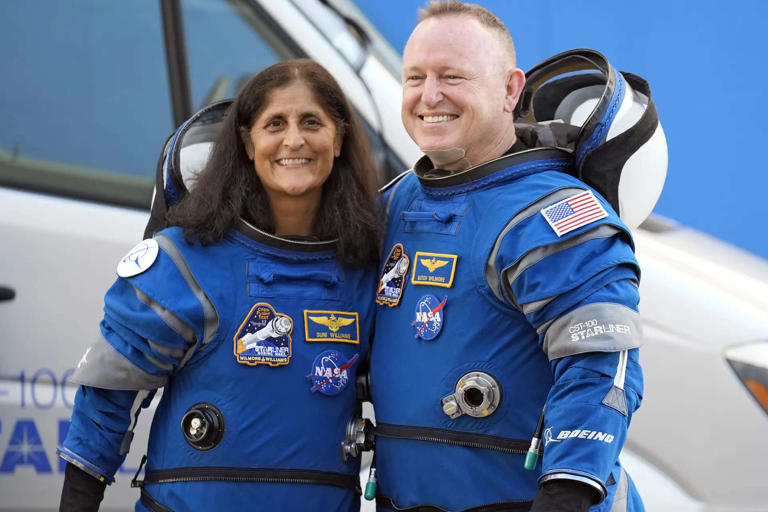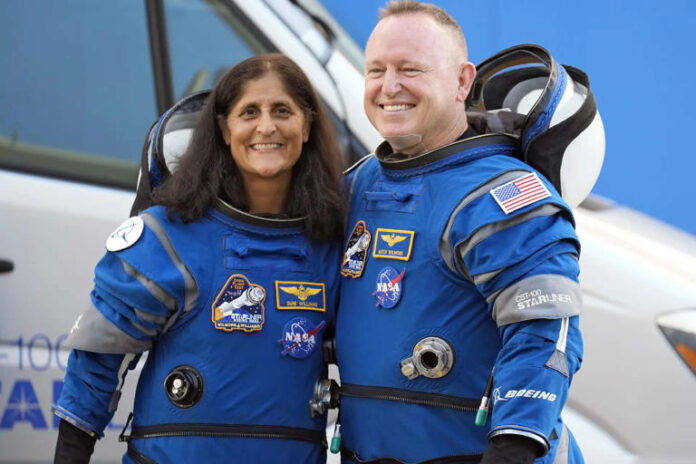On a historic day in space travel, astronauts Sunita Williams and Barry Wilmore said goodbye to the International Space Station (ISS) after 9 months on board the orbital lab. Their mission, a testament to human endurance, cooperation, and the pursuit of scientific discovery, saw both astronauts contribute significantly to the advancement of space research. This article explores the journey of their mission, the challenges faced, their contributions to space exploration, and the remarkable significance of their return to Earth.

Introduction
The return of astronauts Sunita Williams and Barry Wilmore to the Earth from the International Space Station (ISS) is the end of a remarkable chapter in the history of human space travel. Their journey back to the Earth, after staying on board the ISS for a total period of 9 months, is not only an end to their mission but also an indication of the ongoing evolution of humanity’s space ventures. This article explores the intricacies of their mission, the duration of their stay in space, and the significance of their work, which helped advance the frontiers of scientific knowledge and global cooperation.
The Mission to the International Space Station
Sunita Williams and Barry Wilmore started their mission with a grand launch from the Kennedy Space Center on a United Launch Alliance (ULA) Atlas V rocket. This launch, which occurred early in their mission, was just one of many steps NASA is taking to keep a consistent presence in space using the ISS. Sunita Williams, a veteran astronaut with several spaceflights to her credit, and Barry Wilmore, a seasoned astronaut, both contributed valuable experience to the mission.
As they journeyed towards the ISS, the astronauts went through the usual thrill and challenges of entering low Earth orbit. The flight itself lasted a few hours, ending with their docking at the ISS. On arrival, the two astronauts became part of a group of other international astronauts, Russians, Japanese, and European astronauts, who were all striving for a common objective: to further human knowledge in space.
Life Onboard the International Space Station
Life on the ISS is a world apart from life on Earth. The microgravity environment, small living space, and dependence on technology for communication and survival present special challenges for astronauts. Sunita Williams and Barry Wilmore, though, quickly acclimated to these conditions and plunged immediately into the rigorous scientific research and technical work that accompanies long-duration spaceflight.
They spent 9 months undergoing all sorts of experiments from the study of human physiology to material science. Medical doctor Williams provided her services in several life sciences experiments, which focused on understanding the impact of prolonged spaceflight on the human body. It is important to learn this because in the near future, humans are going to go on missions to deep space and even to Mars, and they will spend years in space.
Barry Wilmore, a veteran test pilot, spent much time on engineering experiments and maintenance of the spacecraft. His work in keeping the systems of the station operating smoothly helped to keep the crew safe and the science running uninterrupted. The two astronauts were also tasked with conducting regular spacewalks to keep the exterior of the ISS in good working order and to install and fix equipment that is essential to the station’s continued operation.
One of the most special parts of their mission was that they played a part in international cooperation. The ISS is a beacon of worldwide cooperation, as international astronauts come together to advance human exploration. Williams and Wilmore, and their international counterparts, showed that space exploration is not a matter of national borders, as they worked together in harmony to conquer the challenges of living in space.
Scientific Contributions
The scientific experimentation done over the 9 months spent on board the ISS by Sunita Williams and Barry Wilmore was revolutionary in terms of its various aspects. Through their help, the ISS carried on as a floating laboratory, expanding our knowledge of everything from space medicine to material science and Earth observation.
One of the most important subjects of research done during their stay was the exploration of human health in space. With humans spending longer periods of time in orbit, scientists have been increasingly interested in the impact of microgravity on the body. Such research is crucial for mission planning, particularly for those missions requiring long-duration flight beyond low Earth orbit. Williams, a medical background, was directly involved in experiments that tracked the physiological responses astronauts experience during extended spaceflight. These researches examined bone loss in bone density, muscle atrophy, and cardiovascular wellness—concerns that must be dealt with to travel to places such as Mars.
Barry Wilmore made important contributions to engineering and technology experiments. A prime example was his participation in the testing of new technologies for space habitats and spacecraft, which could be employed on future missions to Mars and the Moon. These technologies involve life support system improvements, space habitat building, and autonomous spacecraft docking—all of which are crucial to the success of deep-space exploration.
Another key focus of research on their journey was Earth observation. The ISS provides an ideal perspective for observing our planet, and the astronauts regularly spend time photographing and monitoring environmental change. Information gathered by Williams, Wilmore, and other astronauts on board the station gave scientists important data on climate change, deforestation, and other issues that affect the environment.
Challenges and Overcoming Adversity
Sunita Williams’ and Barry Wilmore’s travels on the ISS were not problem-free. Life in space is risky by its very nature, and astronauts continually have to find ways to make their new environments work for them. Microgravity can produce an array of bodily effects, including fluid shifts throughout the body, vision changes, and changes in the bone and muscle systems. The lack of gravity can complicate even something as simple as eating, drinking, and sleeping.
In addition, ISS astronauts are dependent upon sophisticated technology and machinery. Failure in the life support systems, power supply, or other critical systems can compromise crew safety. Both Williams and Wilmore had been trained to diagnose and repair these systems, and their technical knowledge was essential to them while they were on board the station.
The psychological effects of long-duration spaceflight are also not to be underestimated. Astronauts are away from family and friends for months, and isolation can cause mental fatigue and stress. Yet the unity between crew members and encouragement from mission control served to keep both astronauts motivated and keep morale high.
Return to Earth
Having spent almost 9 months on the ISS, it was time for Sunita Williams and Barry Wilmore to head back to Earth. Their exit was characterized by a highly choreographed and executed undocking process, after which they entered Earth’s atmosphere in a blaze of fire. The process, though commonplace for veteran astronauts, is always a nerve-wracking and pivotal moment in any mission. The astronauts were forced to trust in their training and the instructions of mission control to make it home safely.
Their re-entry into the atmosphere was a wondrous spectacle. When the spacecraft entered the lower atmosphere of the Earth, it was subjected to extreme friction, producing a brilliant fireball in the sky. This instant, when one goes from the frigid vacuum of space into the warm comfort of Earth, is an experience that characterizes each astronaut. The last phases of re-entry, landing, and recovery were orchestrated to precision, and Williams and Wilmore were brought safely back to Earth, where they were welcomed by loved ones, friends, and fellow space aficionados.
Legacy and Impact
The return of Sunita Williams and Barry Wilmore following their 9-month mission is a moment of pride for the whole space exploration community. Their mission was not just an expression of human strength and resilience but also an embodiment of the future of space exploration. The work they carried out, the technologies they experimented with, and the spirit of collaboration they embodied will keep benefiting humankind for years to come.
As we move forward into the future, the accomplishments of astronauts such as Williams and Wilmore are the basis for even greater ambitions in space exploration. With the mission to return to the Moon, travel to Mars, and build a human presence on other planets, their efforts will remain a driving force behind the next generation of space exploration.
Their homecoming is not the end but is instead the start of a new chapter—one that will motivate generations to come to aspire to the stars and to venture out into the universe beyond earth.
In summary, Sunita Williams and Barry Wilmore’s return to Earth after spending 9 months on the ISS marks a historic moment in space exploration. Their journey was characterized by scientific milestones, technological advancement, and cooperation among nations. As the human race advances its space ambitions, their adventure will be an inspiration and a reminder of the amazing things we can achieve when united in the quest for understanding.

